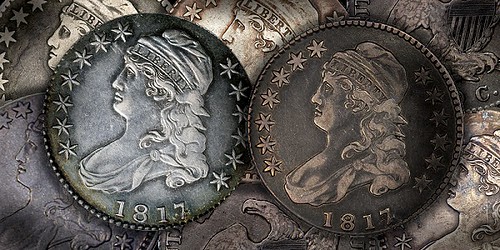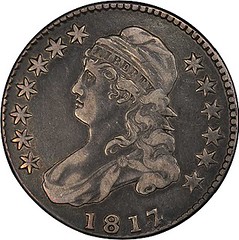
PREV ARTICLE
NEXT ARTICLE
FULL ISSUE
PREV FULL ISSUE
COUNTERFEITING AND 1817/4 OVERDATE BUST HALVES
In his September 16, 2015 CoinWeek column, Greg Reynolds examines the eleven known examples of the famous 1817/4 overdate Bust
Half. Here's a short excerpt, so be sure to see the complete article online. The article raises some interesting points about the
current state of the art in coin counterfeiting. -Editor

Before 2005, just seven 1817/4 overdate bust halves were known and four have curiously appeared since, bringing the total to eleven. The second or third finest is currently ‘in the news.’ The Meyer-Pogue 1817/4 will be auctioned by Stack’s-Bowers on Sept. 30, at Sotheby’s headquarters in New York city. as part of the Pogue II sale. Herein, a tentative condition ranking for this famous rarity is put forth. The 1817/4 overdate bust half is the rarest Philadelphia Mint half dollar that is collected as a distinct ‘date.’ For a given denomination and design type, an overdate can be a second or third ‘date’ of the same year if the overdate feature is readily apparent without magnification. The 1817/3 half, the 1817/4 and the 1817 half with ‘normal numerals’ are considered to be three different dates by collectors assembling sets ‘by date.’ Around the same number of 1838 New Orleans Mint halves survive, between nine and twelve, possibly just nine. The 1838-O, however, is not a business strike and is of a different design type. The Eliasberg-Gardner 1838-O was auctioned in May 2015. The Meyer-Pogue 1817/4
The Meyer-Pogue 1817/4 is a neat coin. The wear is honest and normal. The inner fields toned a brown-russet color and the russet outer fields are green tinted. The highpoints are of a tan hue and contrast well with the deeper toned fields. There are blue-green patches here and there, which naturally layered with the dominating brown-russet tone. Miss Liberty’s hair is blurred and grainy as struck, which is typical for 1817/4 halves. The overdate feature is not as bold as it is on some others, though is clear. Afterthoughts Sheridan Downey strongly believes that the four new discoveries are all genuine. He adds that “it is very likely that more 1817/4 halves will be discovered in the future.” I am not convinced of either point. The underlying four is rather apparent on 1817/4 halves and the premiums attached to this overdate have now been widely reported via the Internet. Are there many ‘1817’ halves that have not been re-evaluated? From 1976 to 2004, there were no new discoveries of 1817/4 halves. On Nov. 29, 2004, the Eliasberg coin sold for $333,500. In the minds of people who make forgeries, this would probably be a rather hefty amount for an obviously circulated silver coin. The other half dollars that are worth more tend to grade above AU-55. People who craft forgeries might have then logically figured that a deliberately worn and harmed, fake 1817/4 could be sold for at least $50,000. Even a net profit of $20,000 might be significant for some forgers. In earlier eras, fake rarities of this nature tended to be accidentally or deliberately mis-attributed die varieties or to be die-struck forgeries with clearly incorrect die characteristics, relating to the placement of numerals, stars, branches, or serifs on letters, among other design elements. With technology developed in the late 20th century, however, there is no longer a need to hand-engrave dies, punches or hubs. An image on a computer screen can be impressed into a die without much human involvement. To a large extent, the die markers on a forgery made with such equipment may be the same as the die markers on a genuine piece. Of course, die-struck forgeries are different from genuine pieces in many ways. In order to reduce the number and magnitude of detectable differences, the forgers may artificially wear or deliberately harm their products; there would thus be less ‘information’ available to be used for authentication. Heavily worn and/or non-gradable “coins” are harder to authenticate than high quality pieces. I am curious as to the methods employed by the experts at PCGS and NGC to authenticate the four 1817/4 halves that appeared since 2004. Supposing, hypothetically, that a forger used a computer and die making equipment that was developed in the late 20th century. Most such equipment was probably geared towards producing the low-relief coins and tokens, with bland and simple design elements, that contemporary mints tended to manufacture during the last quarter of the 20th century. One of the most difficult features for the forgers to reproduce might be the numerals of an overdate, as the effects of overpunching in the 19th century might not be effectively mimicked with automated die-engraving equipment. Therefore, hypothetically, if the numerals of the overdates seem fake on a fake, the forger may scrape the area around the numerals and elsewhere on the obverse to deflect attention from not so deceptive aspects of his creation. In any event, it might very well be true that all four new discoveries are certainly genuine, and I am not suggesting otherwise. I raise these issues because I suggest that collectors who spend large sums on such coins are logically and ethically (though not legally) entitled to an explanation regarding methods of authentication. Besides, even if these four are all genuine and they might very well be, it is certain that there are people in Asia and in Eastern Europe who are producing forgeries of rare coins. There needs to be additional open discussion of methods employed to make fakes and of methods employed to authenticate coins. To read the complete article, see:
THE BOOK BAZARREWayne Homren, Editor The Numismatic Bibliomania Society is a non-profit organization promoting numismatic literature. See our web site at coinbooks.org. To submit items for publication in The E-Sylum, write to the Editor at this address: whomren@gmail.com To subscribe go to: https://my.binhost.com/lists/listinfo/esylum All Rights Reserved. NBS Home Page Contact the NBS webmaster 
|
